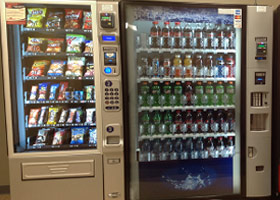Obamacare coming to vending machines, next to the chips and nuts

By Maggie Thurber | for Ohio Watchdog
VENDING: Ohio-based Enterprise Refreshment Services says the cost of adding calorie counts to all food items in their vending machines could be $500,000 per year.
Candy, chips and a helping of Obamacare.
It’s already disrupted the health-care marketplace. Now, the Affordable Care Act is infiltrating vending machines.
Yep, a provision in the Affordable Care Act requires vending machines to display the calorie content of all food items. The FDA finalized the regulations April 3.
If you know the calorie content of an item, you might make a more healthy choice. Or so the thinking goes.
The agency admits 95 percent of the companies affected by the new rules are small businesses, such as Ohio’s Enterprise Refreshment Solutions.
Chris Heaton, director of sales for Enterprise Vending Inc., said his company can now begin to calculate costs. It won’t be cheap.
“It’s an investment without any return to the company,” Heaton said.
If the FDA estimates of less than $10 per vending machine for compliance costs are accurate, “the impact to Enterprise will be close to $500,000 annually.”
Based on industry estimates of one vending machine for every 40 adults, the total cost for Ohio businesses could be more than $2.2 million each year.
Nationally, the FDA estimated businesses will incur $40 million in additional costs — $25.8 million for initial implementation with a “recurring cost of approximately $24 million.”
Does the FDA expect vending companies to eat the cost of the regulation?
“Unfortunately, that is realistic to expect,” Heaton said. “Just knowing the industry, the costs and the prices, there will be companies that struggle with the cost, the needed manpower, the labor and the printing to be able to cover the mandate with their current prices.”
He doesn’t think his competition will allow Enterprise to pass along the costs.
Under the rules, any person or business who owns or operates 20 or more vending machines must provide a “clear and conspicuous statement disclosing the number of calories contained” in the food being sold. That means a sign or other notice on or near the food item.
But this is government, so it’s not that simple.
For instance, businesses will be allowed to use the abbreviation “cal” instead of the entire word “calories.” But if the food item is a sandwich, the total calorie count must include the condiments packaged with it.
If a bag of chips has two 180-calorie servings, the declaration must say 360 calories — because you might eat the whole bag.
The FDA won’t dictate a specific type size or font for the calorie declarations, but it does require they be in the same color and same contrast — or at least as conspicuous — as the name and price of the item. The type size can’t be smaller than the name of the food, the price of the food or the selection number on the machine.
If the required sign is adjacent to the vending machine it must be “in type that is all black or one color printed on a white or neutral background that contrasts with the type color.”
Good luck with that.
“But you don’t want to put all the information on one poster or one sheet because, if anything changes, you have to replace the entire sheet or poster on all your snack machines,” Heaton said. “It’s going to be a challenge to figure out the best method of implementation.”
The FDA says vending machine operators have an obligation to “ensure that the calorie declaration is truthful and not misleading.” This would apply to any product for which the manufacturer doesn’t provide calorie content.
“If you’re dealing with a vending company with hundreds of items of fresh food, it will be almost impossible to comply with,” Heaton said. “It will be something we try to comply with, but it will be hard to prove the (calorie) content if they want to investigate.”
Heaton said the industry, as a whole, lobbied for conformity.
“I don’t think the industry hasn’t taken responsibility, as our customer base evolves to be more healthy, but it’s a big investment and it’s a lot more involved than just saying, ‘Let’s do this,’” he explained. “It takes a lot of planning, and if you put all the time and effort into it and then the FDA puts out regulations that are different than what you did, suddenly all the work you did is wasted.”
Heaton said it is possible some people will gravitate toward healthier items if they can compare the calories of the items.
“People generally know when they buy a Snickers that it’s high in calories and fat,” he said. “But they still make that choice.”
“It’s a good intention,” Heaton said, “but when it comes down to real-world implementation, does it work to accomplish the goals? That’s up for debate.”
The regulations go into effect in 2015.







